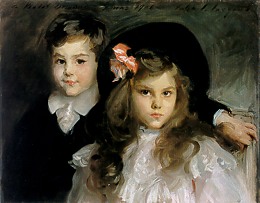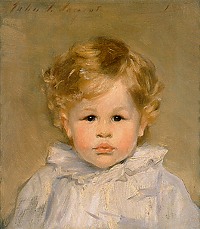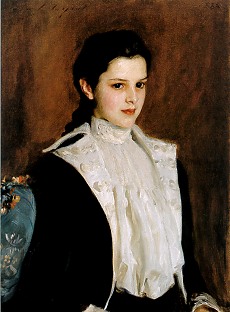
Caspar Goodrich,
1887
Oil on canvas, 26 x 19 inches.

Conrad and Reine Ormond,
1906
Oil on canvas, 23 x 29 inches.

Daniel de Mendi Macmillan,
1887
Oil on canvas, 16 x 14.

Alice Vanderbilt Shepard,
1888
Oil on canvas, 30 x 22 inches.

Dorothy, 1900
Oil on canvas, 24 x 19 inches

John Alfred Parsons Millet,
1892
Oil on canvas, 36 x 28 inches.
|
|
Portrait of John Singer
Sargent, 1889
By Giovanni Boldini
 here
are important lessons for every working portrait artist
to be gained from the study of John Singer Sargent's
portraits of children. Ample opportunity for this was
provided by the Brooklyn Museum in their major exhibition
Great Expectations: John Singer Sargent Painting
Children. here
are important lessons for every working portrait artist
to be gained from the study of John Singer Sargent's
portraits of children. Ample opportunity for this was
provided by the Brooklyn Museum in their major exhibition
Great Expectations: John Singer Sargent Painting
Children.
Portraits of children comprise a huge percentage of
contemporary portrait practice. Several of today's major
portrait brokerages find portraits of children making
up as much as 90% of their annual business totals. Many,
many artists across the country are active in this field.
We find it unfortunate that the major lessons to be
learned from Sargent are being regularly ignored by
far too many of today's artists.
The first lesson from Sargent is apparent from the examples
on this page: i.e., the artist should treat the child
subject as one would an adult subject. In far too many
contemporary children's portraits, the subject is portrayed
in a candid, animated pose, betraying the image's origins
in an unposed photographic snapshot. In contrast, in
a Sargent portrait, the child sits or stands opposite
the artist, in complete soberness and dignity, and comes
across in the painting as a full-fledged human being
of significance.
The portrait of Caspar Goodrich shows us a thoughtful
young lad of, perhaps, nine or ten years, arms crossed
in a manly pose, regarding the world with a very composed,
level glance. The only concession to childhood is the
then-popular sailor suit. This dark suit is expressed
by the artist in a most summary fashion, with sweeping
broad strokes of very fluid black paint. No labor at
all is expended on a careful rendering of the folds
and details of the suit. The background is struck in
with broad washes of liquid color.
The Ormond Children (son and daughter of Sargent's
sister Violet) sit side by side in contemplation of
the great artist who is rendering their likenesses—neither child quite sure what to make of the experience.
Daniel Macmillan is painted—just head
and shoulders—on a tiny canvas, but very expressive
and resolute.
Alice Vanderbilt Shepard looks to our right and
downward, avoiding our gaze. Her expression is one of
far-away composure and thoughtfulness. What a striking
contrast between this handsome, dignified portrayal
and much of the sentimental foolishness that passes
for child portraiture in the twenty-first century!
Even little Dorothy has a grown-up pose, sitting
in her great chair dutifully, and enduring her Victorian
costume with determination. The result is quite charming.
We are forced to consider Dorothy as a human individual
of substance, in spite of her very few years.
John Alfred Parsons Millet looks down from his
fortress of pillows and wears his long curls with dignity.
By now, my artist colleagues who paint children's portraits
(I don't) are readying their objections to this line
of commentary. I have been assured hundreds of times
that "parents demand a cute, informal, casual pose"
preferably with a smiling expression.
That may well be the reality confronting the contemporary
painter of children's portraits. But I nevertheless
challenge all artists to work diligently to put distance
between themselves and the photographic reference that
so obviously lies behind so many painted images. The
best way to do that is to study the images of Sargent's
portraits of children.

 The
Brooklyn Museum has published a very handsome hardcover
catalog of the exhibition entitled Great Expectations:
John Singer Sargent Painting Children. The volume
may be ordered online at the Brooklyn
Museum Store. The
Brooklyn Museum has published a very handsome hardcover
catalog of the exhibition entitled Great Expectations:
John Singer Sargent Painting Children. The volume
may be ordered online at the Brooklyn
Museum Store. |
|